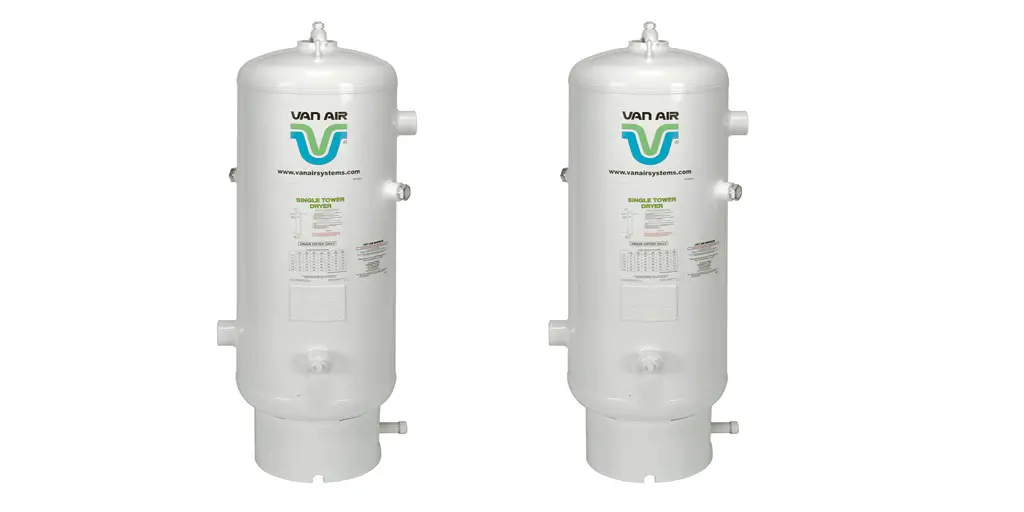Compressed air is critical in various industries, particularly in plastics manufacturing. But there's one element that can thwart its effectiveness: moisture.
Picture an industrial setting where precision, quality, and efficiency are paramount. Add moisture to the equation, and what you get is a potential minefield of problems. This is where compressed air dryer systems come into play, particularly regenerative compressed air dryers.
Why Regenerative Compressed Air Dryers?
Regenerative compressed air dryers stand out because of their unique mechanism. They leverage desiccant material, a substance famed for its moisture-absorbing prowess.
What makes these dryers a remarkable feat of engineering is the regeneration process. Unlike typical dryers that might get saturated over time, regenerative dryers maintain their efficiency by continually regenerating the desiccant material through heating or dry air purging.
Let's delve deeper into the myriad benefits they offer:
Moisture Elimination: Their core competence lies in their ability to eliminate moisture to very low dew points. Given that many industrial applications demand stringent moisture control, this efficiency is vital.
Energy Efficiency: In an industry where the electric meter is always ticking, saving on energy costs is a win. Regenerative dryers use minimal energy, primarily to heat the desiccant in the regeneration chamber.
Durability: Built from robust materials, these dryers are tailored for industrial rigors. They're resilient, ensuring longevity and value for money.
Low Maintenance: Time is money. And with regenerative dryers, you save both. Their low maintenance requirements translate to fewer disruptions and cost savings.
The Havoc Wreaked by Moisture in Plastics Manufacturing
The importance of moisture elimination cannot be overstated, especially when you consider the multitude of problems it can trigger:
Contamination: Moisture, even in trace amounts, is a nemesis for plastics. It interacts with the materials, initiating reactions that degrade the integrity of the plastic. The end result? Products that may appear clouded, discolored, or even brittle. Beyond just aesthetics, these structural alterations can weaken the plastic, making it less durable and prone to breakage.
Blistering & Warpage: Blistering and warpage take the moisture problem to another dimension. Imagine investing time, resources, and effort into producing a flawless plastic item, only for moisture to sabotage your hard work. What was once a meticulously designed shape might now appear misshapen or distorted. In industries where precision is non-negotiable, such imperfections can be costly.
Metal Damage: Moisture accelerates the wear and tear on these essential items. Corrosion, that rust-like fiend, finds a welcome environment when moisture is present, cutting short the lifespan of metal tools. Erosion, though subtler, can also degrade machinery over time. When the backbone of your production process faces such threats, the repercussions on efficiency and output can be significant.
Electrical Hitches: Moisture and electricity? A recipe for short circuits and arcing issues. Electrical components and systems integrated into the manufacturing line are vulnerable to short circuits when exposed to dampness.
Health Concerns: An environment ripe with moisture is a playground for mold and bacteria. These organisms can rapidly colonize spaces, threatening the health of workers. Respiratory issues, allergic reactions, and even long-term health complications can arise, turning a production facility into a health hazard zone.
Given these challenges, it's clear why maintaining optimal moisture levels in the air is crucial. And this is where compressed air dryer systems prove indispensable, enhancing the quality, cost-effectiveness, and safety of plastics products.
Navigating the World of Compressed Air Dehydration
Once compressed air leaves its source, the compressor, it's far from ready for action. It's hot. It's wet. It's dirty. Preparing it for its role requires cooling, filtering, and drying.
Now, the market brims with various dryer systems, each touting its own set of benefits and limitations. Your choice hinges on the specifics of your process and its moisture demands.
If you're navigating this maze, seeking the ideal fit for your application, look no further. AirVacuumProcess.com stands ready to guide you, ensuring you pinpoint a system tailored to your moisture requirements. Don't hesitate—reach out to them and make a decision that will set your plastics manufacturing on the path to uncompromised excellence.
For more information about Automatic Drain Valve and Natural Gas Dehydration Unit Please visit: Air & Vacuum Process Inc.







